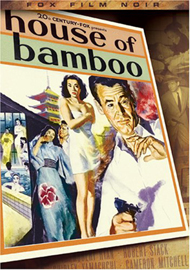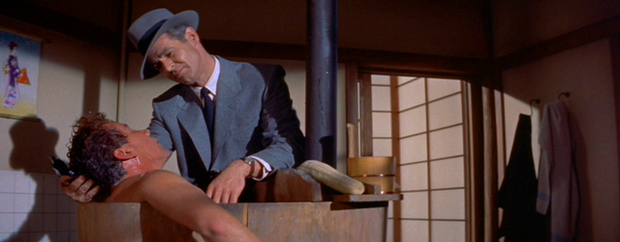| Release List | Reviews | Price Search | Shop | Newsletter | Forum | DVD Giveaways | Blu-Ray/ HD DVD | Advertise |
| Reviews & Columns |
|
Reviews DVD TV on DVD Blu-ray International DVDs Theatrical Reviews by Studio Video Games Features Collector Series DVDs Easter Egg Database Interviews DVD Talk TV DVD Talk Radio Feature Articles Columns Anime Talk DVD Savant HD Talk Horror DVDs Silent DVD
|
DVD Talk Forum |
|
|
| Resources |
|
DVD Price Search Customer Service #'s RCE Info Links |
|
Columns
|
 |
House of Bamboo
|
||||
The Fox Film Noir collection adds a prime Sam Fuller title to its list of thrillers with House of Bamboo, a uniquely weird crime story that represents the high point of the director's relationship with Darryl F. Zanuck. Fuller proposed a movie set in Russia that Zanuck turned down, only to be offered the dream assignment of shooting the company's first picture in Japan, only ten years after the end of the war. He came up with an adaptation of the earlier noir, The Street with No Name, combining it with an idea he had for a gang of crooks that plot their crimes with military planning strategies. Beautiful CinemaScope photography in the streets of Tokyo lends the completed film a needed air of authenticity, because in almost every other respect the story premise is absurd. Comic-book gangster business mixes with an exotic setting for an undeniably bizarre picture; Sam Fuller's dynamic direction made him the darling of the French Cahiers du Cinema critics.
What's wrong with this picture? In the middle fifties Americans were assured that Japan was a completely pacified nation with almost no crime and few weapons in civilian hands. American visitors would feel safer on the streets of Tokyo than they might in their own home towns. By and large that picture was true, but according to other sources Japan was giving birth to a thriving new Yakuza underworld that controlled gambling and vice through organized crime very similar to the American model. House of Bamboo puts forward the amazing conceit that a gang of American criminals, most of whom do not speak the language, could operate Pachinko parlors while carrying out wild-west style armed robberies, holdups and murders right in the middle of Tokyo. Anyone familiar with a later films like Battles Without Honor and Humanity will immediately realize that Robert Ryan's Sandy and his pushy crew would be turned into sushi the first time they tried any muscle business on Yakuza turf. Surely there were plenty of black market crimes involving servicemen and perhaps a few ex-servicemen, but the idea of Gangland USA operating on the Tokyo streets is comic-book stuff. Sam Fuller's script is an ex-soldier's escapist fantasy, an occupation daydream. Sandy and his men all have mistresses they call "kimonahs" (sic), pliant Japanese beauties who do the Lindy Hop when not serving formal tea. This would seem to be the reward for victory - breakfast in bed with a smiling Japanese "kimonah." No wonder Fuller alluded to protests following his film crews on the streets of Tokyo. He mentions the protesters scattering when he turned his cameras on them - the occupation was officially over (or nearly over) but the fear of arrest must have been real. Of course Sam Fuller had no intention of insulting the Japanese, quite the opposite. In its own way his film shows respect for the nation and at least acknowledges that there is a separate culture worth appreciating. The interesting thing is that any other director would realize how ridiculous the premise was, while Sam just saw a great story in an exotic locale and proceeded to make one of his most exciting and interesting pictures. Robert Stack's Spanier character stomps through Tokyo like a thorough Ugly American, yelling at people for not speaking English and roughing up Pachinko operators (later revealed to work under American gangster bosses) before connecting with cool operator Sandy. Fuller's style might be called comic book/travelogue/graphic. At one point Spanier walks a complicated path of gangplanks between some boats on a canal, ostensibly to ask some questions but really to show off the undeniably authentic location. He tries to find Mariko, the widow of an American gangster (Shirley Yamaguchi), and comes upon a kabuki troupe rehearsing on the roof of their theater. The obvious reason why they're up there in the cold is to get the color and costumes out into the daylight for a dynamic trucking shot, and to avoid an interior lighting situation - most of the interiors seem to have been shot back on the Fox lot in Los Angeles. Spanier meets Sandy in a nifty reveal when Cameron Mitchell knocks him through a CinemaScope-shaped paper screen. The entire gang is waiting on the other side. With the trip to Japan the film's one fiscal extravagance, Fuller cut corners where possible. Most of Sandy's gang do not appear on the Tokyo locations and probably never left Hollywood, although Cameron Mitchell is seen outside a castle moat and Robert Ryan definitely shows up for the finale. A second look at the picture is required to catch all of the Japanese locations matched (presumably) with California stage settings. It appears that critic-turned-director Jean-Luc Godard used Eddie Spanier as a behavorial model for his take on the Lemmy Caution character in Alphaville ten years later. Both secret agents are strangers stalking through an alien culture with contempt for most everything they see, at least until an attractive skirt catches their eye. House of Bamboo traces themes through decades of crime films. Sandy hands over a wad of bills for Spanier to use to buy a new suit. "I like my boys to look sharp," says Sandy, a line that echoes Little Caesar while also introducing a screwy homoerotic theme to Sandy's obvious psychosis. Other scenes like the execution of a wounded comrade during a getaway, and the way a train robbery is blocked with the thieves attacking from beneath a railroad overpass, point forward to The Wild Bunch, a movie that blends Western and Gangster mythology. The movie pays off with two kinds of spectacle. Fuller stages a (for 1955) wild shootout at a fascinating kiddie playground atop a multi-story department store, which was owned by Nikkatsu of movie studio fame (according to Fuller's autobiography). A giant ride at the very top suspends the little kids eight or ten floors above the street, which seems like insanity to this parent. But it makes a unique location for a final duel. Besides Fuller's realistic use of bullet impacts and stereophonic sound effects, the globe-shaped ride harkens back to the "Top of the World" theme from White Heat or the various mentions of "Cook's Tours" and "See the World" in the earliest of gangster films. An even more sensational pre-climax is the culmination of the Sandy Dawson mania. It may have been invisible to all the actors save Robert Ryan, as Fuller claims, but Sandy's preferential attraction to Robert Stack couldn't be more obvious. Sandy asks the whole gang why he broke his own rule and saved Spanier, while Griff looks hurt and jealous in the background. Sandy's military obsession is shown to be just one facet of his psychosis, as he takes personal charge of Spanier and makes it his business to supervise Spanier's kimono Mariko, as if she were his proxy. With Robert Stack playing most of his scenes with the same blank stare, this is Robert Ryan's film all the way. (spoiler)Finally, Sandy's mistaken revenge against a squealer results in just about the kinkiest violence ever in a film noir - he bursts into a Japanese bath and without pause empties six shots through a wooden bathtub. Then he gently lifts the head of the man he's just killed and explains why it was necessary. Even today, the scene is so jolting it often gets an unintentional laugh, an audience defense mechanism against the outlandishness of it all. Fuller's staging and Ryan's performance in the one-shot scene are remarkable. |
Review Staff | About DVD Talk | Newsletter Subscribe | Join DVD Talk Forum
Copyright © DVDTalk.com All rights reserved | Privacy Policy | Terms of Use
|
| Release List | Reviews | Price Search | Shop | SUBSCRIBE | Forum | DVD Giveaways | Blu-Ray/ HD DVD | Advertise |







